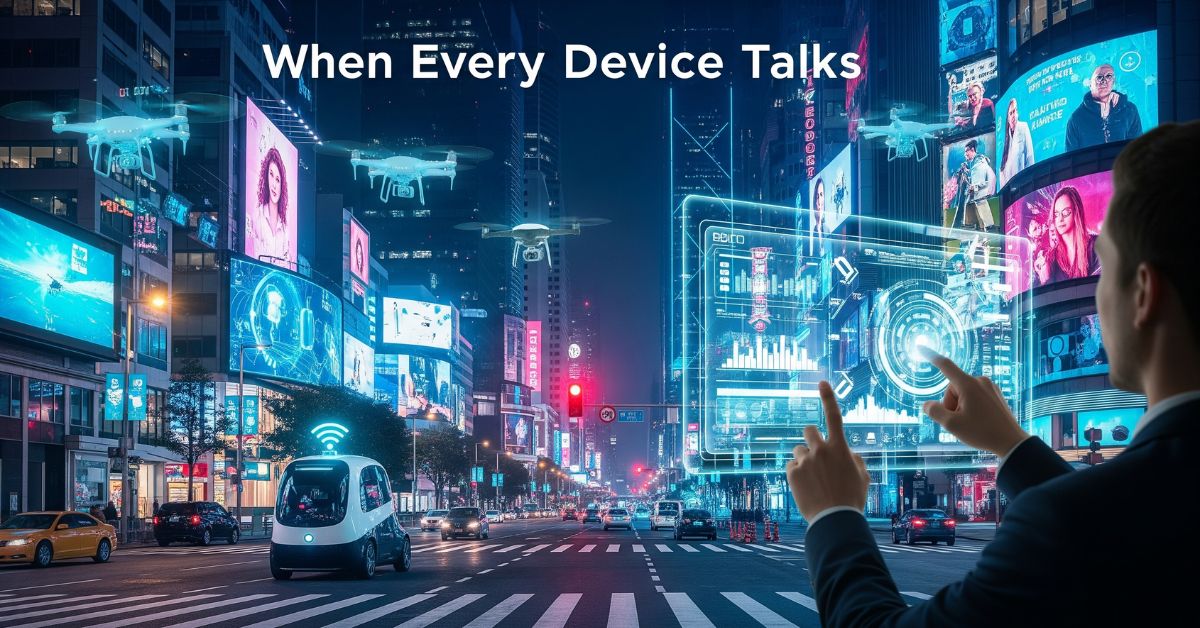The world around us is no longer silent. From our smartphones and refrigerators to street lights and industrial machines, devices are talking—and they’re not whispering. This is the Internet of Things (IoT) in overdrive: a digital revolution where interconnected gadgets share data, make decisions, and redefine how we live, work, and think. But what does this constant communication really mean for our daily lives, industries, and future?
What Is the Internet of Things (IoT)?
At its simplest, IoT is a network of physical devices embedded with sensors, software, and technologies that allow them to connect and exchange data with other devices and systems over the internet. Imagine your smartwatch measuring your heart rate, sending the data to your phone, which then alerts your doctor if something seems wrong. Or your smart thermostat adjusting the temperature because your calendar knows you’re on vacation.
That’s not science fiction—it’s already happening.
From Convenience to Complexity
We’re no longer just talking about a smart speaker playing your favorite song or a fitness band counting your steps. Today’s IoT landscape includes smart cities, automated factories, connected cars, intelligent agriculture, and even predictive maintenance in aerospace. These devices are generating massive amounts of data—terabytes every day—allowing systems to learn, adapt, and evolve in real-time.
But with every convenience comes a new layer of complexity.
When your devices are constantly “talking,” several important questions arise: Who is listening? What data is being collected? Is it secure? And what happens if the system fails?
Everyday Life, Upgraded
Let’s zoom into everyday life. You wake up in the morning and your smart alarm adjusts itself based on traffic data and your first meeting. Your coffee machine starts brewing before you even reach the kitchen. The fridge tells you you’re out of milk and places an order. Your car navigates the fastest, least-congested route to the office, and your smartwatch reminds you to hydrate.
This seamless integration is designed to optimize your time, health, and decisions—almost like having a personal assistant built into your surroundings. The more these devices learn about your habits, the better they can serve you. But as helpful as this sounds, it also means surrendering a significant amount of personal data.
Industry 4.0: When Machines Collaborate
IoT is not just transforming homes—it’s revolutionizing industries. In manufacturing, this transformation is often referred to as Industry 4.0. Machines equipped with sensors can now monitor themselves, communicate with other machines, and make adjustments without human intervention.
For instance, if a conveyor belt in a factory detects that it’s running too hot, it can slow down or shut off automatically while simultaneously alerting a technician and scheduling maintenance. This kind of predictive analytics prevents costly downtime, reduces waste, and boosts efficiency.
In agriculture, smart sensors can measure soil moisture, predict weather, and help farmers use water and fertilizers more efficiently. In healthcare, wearable devices and remote monitoring tools are saving lives by enabling early diagnosis and continuous care.
IoT, in short, is creating systems that are not only smart—but also self-sufficient.
The Data Dilemma
However, there’s a catch.
The more devices we connect, the more data we generate. And with data comes responsibility. One of the biggest concerns in an IoT-driven world is data privacy and security. If a hacker gains access to your smart home hub, they could potentially unlock your doors, watch you through cameras, or steal sensitive information.
On a larger scale, if industrial systems are breached, it could disrupt production lines, tamper with sensitive information, or even pose national security threats. In 2021, a water treatment plant in Florida was hacked via a vulnerable remote access system, and the attackers attempted to increase levels of a dangerous chemical in the water supply. Luckily, it was caught in time—but it highlights how vulnerable some systems still are.
Interoperability: Speaking the Same Language
Another challenge is interoperability—getting different devices and platforms to work together. With so many manufacturers creating IoT devices, there’s often a lack of standardization. Your smart bulb might not talk to your smart speaker unless they’re from the same brand or compatible via a shared platform like Apple HomeKit or Google Home.
Efforts are underway to fix this. Initiatives like Matter, a new open-source, royalty-free connectivity standard, are trying to create a universal language for IoT devices so they can seamlessly communicate—no matter the brand.
The Road Ahead: Smarter Cities, Better Living
Looking ahead, the potential of IoT is vast and promising.
Imagine cities where traffic lights adjust in real-time based on congestion, where garbage bins alert collection teams when they’re full, or where sensors monitor air quality and inform policy changes. These “smart cities” are no longer just an idea—they’re in development worldwide.
Even transportation is changing. Autonomous vehicles rely heavily on IoT sensors and data to navigate roads safely. And logistics companies now use IoT to track shipments, predict delays, and reduce fuel costs through smarter routing.
IoT is also becoming a key player in sustainability. By optimizing energy usage in buildings, reducing food waste in supply chains, and monitoring natural resources, IoT can help us reduce our environmental footprint.
Final Thoughts: Are We Ready?
We’ve entered an era where silence is no longer golden—our devices are in constant dialogue. The question is: are we ready to listen, manage, and govern this digital conversation responsibly?
As IoT accelerates into overdrive, it promises a world that’s more connected, efficient, and intuitive. But with great connectivity comes great responsibility. We need to balance innovation with regulation, convenience with privacy, and growth with ethics.
After all, when every device talks, we need to be smart enough to understand what they’re saying—and wise enough to decide who gets to hear it.
